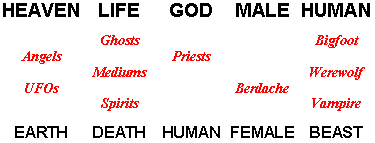Primary topics include:
-
Binary oppositions
-
Liminality
-
Anti-structure
-
Marginality
-
Taboo
-
Reflexivity
-
Structuralism
-
Totemism
-
Charisma
Binary opposition is a key concept. Liminality
and the trickster blur and invert oppositions.
Paranormal phenomena have the properties of liminality,
anti-structure, communitas, interstitiality, and the betwixt and between.
The phenomena are located between major binary oppositions.

Major Binary Oppositions and the Paranormal Phenomena and Practitioners
Between Them
Note: The elements in the top row typically hold
the greater power, prestige, and status.
Edmund Leach explained that the realm between
gods and humans was surrounded by taboos. It was dangerous, inauspicious,
polluting. Mary Douglas made similar observations in Purity and
Danger (1966). Durkheim’s The Elementary Forms of the Religious
Life (1912) also addressed taboo. The betwixt and between region
is typically sacred, and a source of miracles.
Early studies of primitive classification, taboo,
magic, religion, and the irrational are relevant to today’s disputes over
the reality of paranormal phenomena. Taboos still operate, though
nearly everyone is unconscious of them.
Liminality theory explains change, transition, and
transformation. Durkheim and the later structuralists addressed order
and stability. The two approaches are complementary. The
Trickster and the Paranormal integrates both.
Paranormal phenomena become prominent under conditions
of anti-structure, that is—instability, marginality, and transition.
Also, paranormal groups lack stability; they attract marginal persons as
well as those undergoing transition. The trickster shares these characteristics.
Anthony F. C. Wallace’s work on cultural revitalization
movements demonstrated how charismatic leaders emerge during times of significant
social change. The dissolution of the U.S.S.R. provided recent examples.
(By the way, Max Weber’s concept of pure charisma explicitly included paranormal
powers.)




![]()
